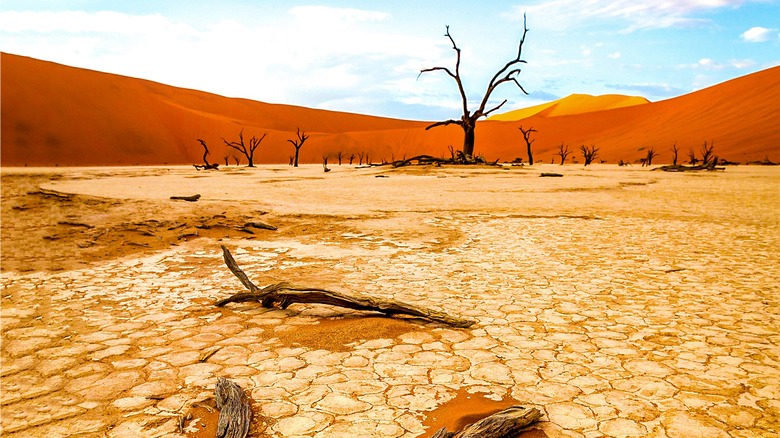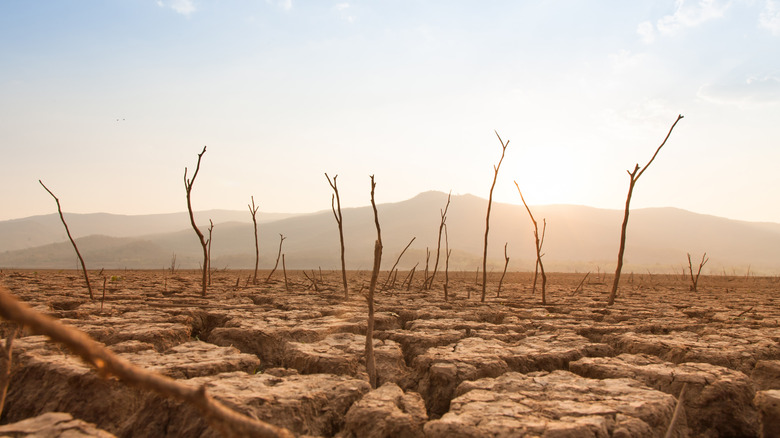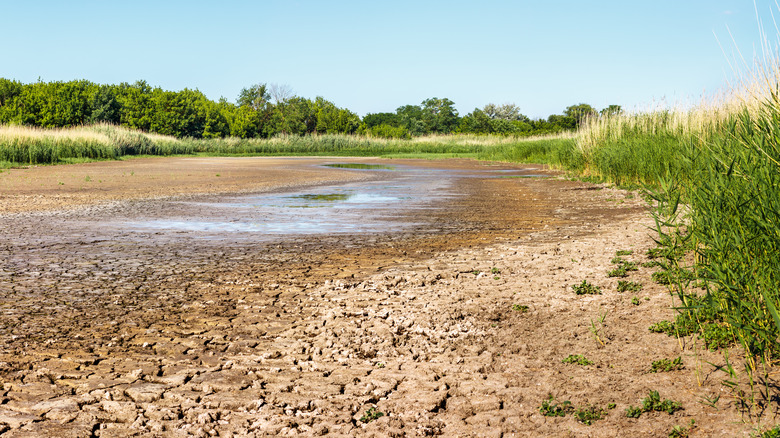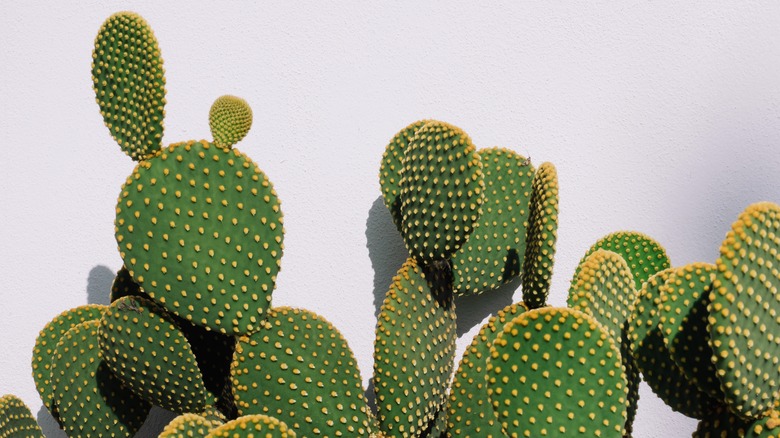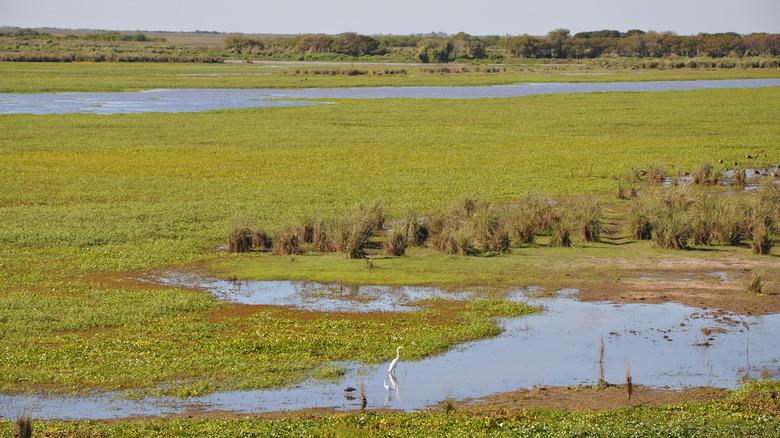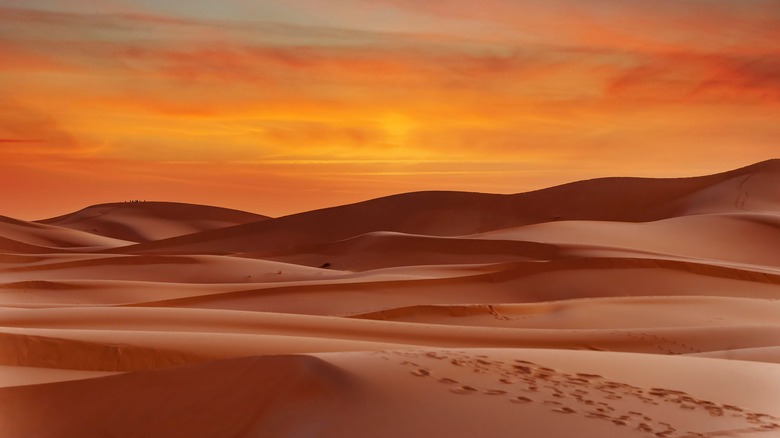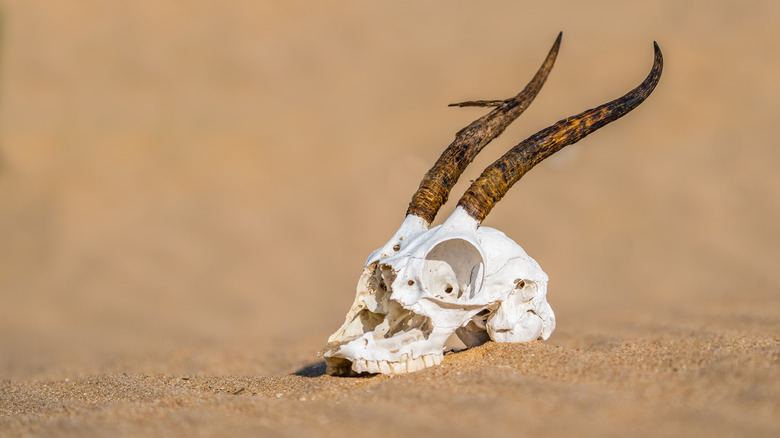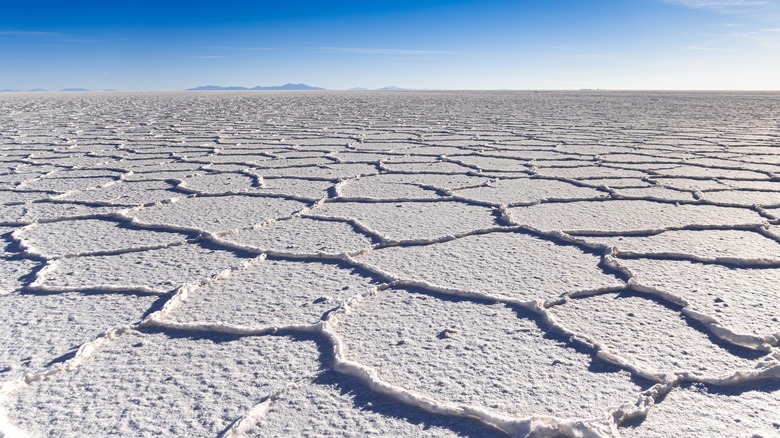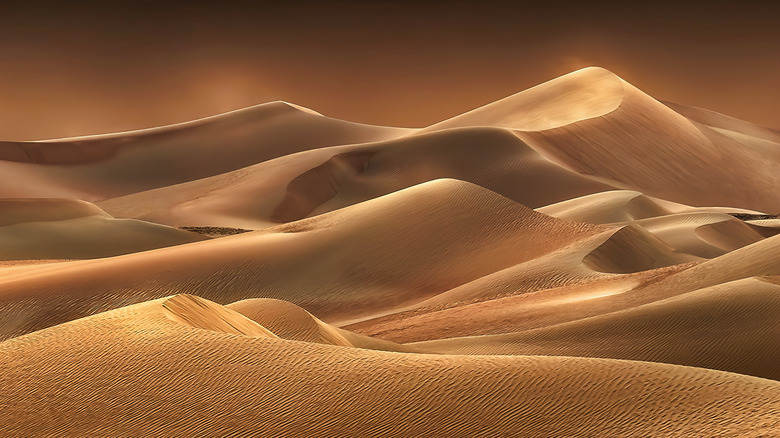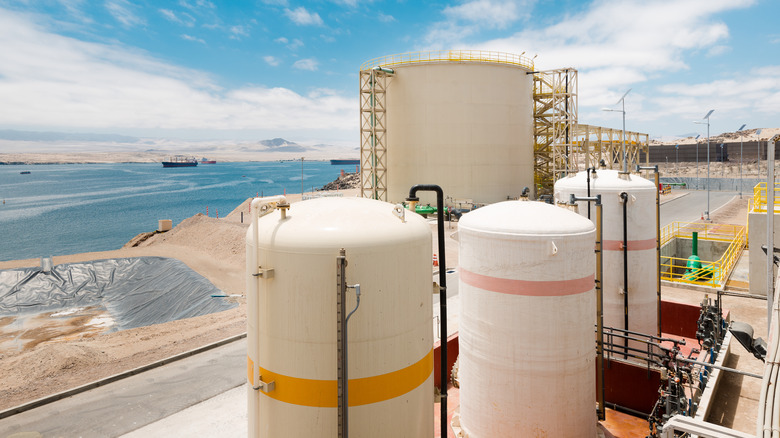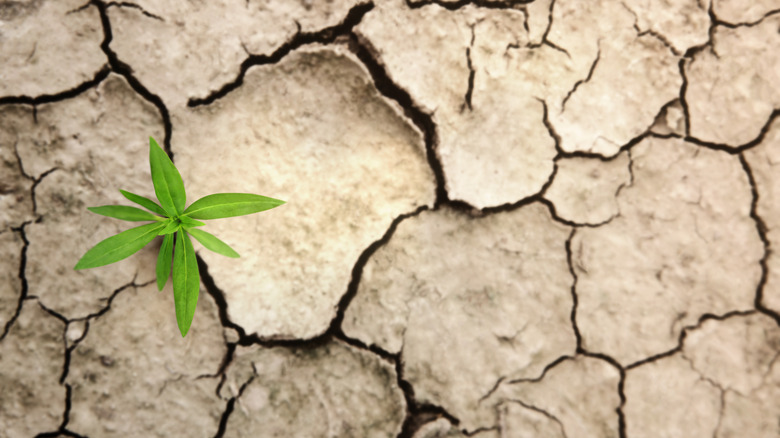Here's What The World Would Look Like Without Rain
In day-to-day life, most people consider rain to be little more than a nuisance, dashing for cover or opening umbrellas as it starts to fall. But rain is a vital part of what makes the world work and, as the NOAA explains, Earth needs water to survive. Rain is part of the water cycle, a complex set of processes through which water evaporates into the atmosphere before condensing and falling back to the surface as precipitation. It's always raining somewhere in the world. Per Britannica, averaged across the surface of Earth, around 39 inches of rain falls every year -– though, in reality, it's never so evenly distributed.
Life on land relies on fresh water, but it's surprisingly rare. According to the United States Bureau of Reclamation, while most of Earth's surface is covered in water, only 3% of all Earth's water is fresh. Most of this isn't even accessible — so much of Earth's life, including all of humanity, relies on just 0.5% of all water on Earth. Rain is an essential source of it, and climate change is already disrupting that source. A paper published in Nature Communications explains how shifting weather patterns caused by long term climate change are affecting the availability of water around the world. Decreased rainfall can have a severe impact on vast swathes of land, but if rain were to somehow stop falling altogether, the effects would be nothing short of catastrophic. A world without rain would rapidly become an extremely dry and hostile place.
Widespread drought and desertification
If rain were to permanently stop falling from Earth's skies, the first thing to happen would be terrible worldwide droughts. The summer of 2022 gave the world a taste of what this might look like. As BBC News reports, lack of rainfall caused droughts around the globe in 2022, leading to dire consequences. Parts of Africa experienced severe famine while rivers and reservoirs began to dry up across Europe, East Asia, and North America. The results were fields of dead, yellowed grass and increasingly severe forest fires.
As well as the ecological effects, droughts can exacerbate water scarcity as entire communities have increasing difficulty finding the fresh, clean drinking water they need to survive. As U.N. Water explains, water scarcity is already a problem in many parts of the world, and in a world with no rain, that problem would become much worse.
Disconcertingly, as Euro News notes, severe droughts could become commonplace by the year 2050, even as rain still falls. If there were no rain at all, the situation would rapidly become a crisis. The National Drought Mitigation Centrer explains how the effects of droughts, both on people and the environment, can be severe and deadly. But on an Earth where rain no longer fell, even the worst droughts would be just the beginning of the world's woes.
Rivers running dry
If rain stopped falling altogether, the droughts would continue to worsen. Quite quickly, rivers would begin to run dry, and both the human populations and wildlife that rely on them for survival would become seriously threatened. The droughts of 2022 also gave an impression of how serious this could be. As The Guardian reports, Europe suffered the most severe droughts in half a millennium, causing even some of the most major rivers on the continent to dry up so much that they were crossable on foot in places. The dry rivers had a big impact on human industry and society, as important shipping routes were suddenly unavailable causing supplies to be cut off. But some of the most serious impacts, as The Rivers Trust explains, are environmental. The lack of water when a river dries up can devastate entire ecosystems, while also severely degrading the quality of any water that remains.
Rainforests would most definitely suffer if Earth's rivers started to dry up. As Mongabay notes, rainforests are associated with some of the world's largest and most famous rivers, like the Congo, Orinoco, Mekong, and Amazon. If these rivers were to stop flowing, the entire forests they support would start to die back. Needless to say, there would be no rainforests on an Earth with no rain.
Drought-tolerant plants
As any gardener will tell you, most plants will rapidly wither and dry out without water. The reason, per the Royal Horticultural Society, is that plants need to gather enough water through their roots to sustain their foliage. But some plants are already drought-tolerant, and they'd likely last a lot longer after the rain stopped falling.
The most famous plants to make their homes in arid environments are cacti and, as Live Science explains, they have a variety of survival tricks hidden up their green sleeves. Among other things, cacti only open up their pores at night, when they won't lose too much moisture under the hot sunlight. Their waxy skin helps them retain water, which is stored plentifully in a cactus' thick, fleshy trunk. As the ground dries out, cacti have one final trick. Their roots start to die off, so the plant can conserve as much water as possible without the risk of losing any to the desiccated ground.
Elsewhere in the world, other plants have evolved similar strategies, and one famous example is the baobab tree. Several species of baobab grow across Africa, with some of the most iconic found in Madagascar. As South Africa's Baobab Foundation explains, these trees use similar tricks to cacti, with up to 75% of their enormous trunks used to store water, which they take care not to use unless necessary. In the end though, even the most resilient of plants need water, which means they too depend on rain.
Aquifers will slowly deplete
The surface of Earth is dotted with aquifers, reservoirs of fresh water lurking below the ground. These can be surprisingly vast, supporting entire ecosystems with the water they've stored. One prominent example is Australia's Great Artesian Basin (via Geoscience Australia). It's one of Australia's most important water sources, containing just under 650,000 square miles of it. As a study published in Wetlands Ecology and Management notes, however, even these huge subsurface reservoirs need rainfall to recharge, and it's already becoming depleted due to human activity.
If Earth's rainfall was to cease, groundwater aquifers like these may provide some of the last havens for life on land, and they could last for some time. Hawaii is another place that relies on its huge aquifers for fresh water and, as New Scientist reports, Hawaii's freshwater can even be found beneath the sea. According to Mālamalama, water in Hawaiian aquifers has already spent 10-20 years slowly seeping through volcanic rock after falling as rain. Aquifers like these may be able to provide plants with a foothold for several years if rain was to stop falling. But they wouldn't last forever. As the U.S. Geological Survey explains, all groundwater is ultimately replenished by rain. With no rainfall, even the largest of Earth's aquifers would eventually dry out.
Oxygen levels will fall
Without rain, there would eventually be no plants. And without plants, Earth would have no oxygen. As the rain stops and plants begin to die off en masse, the atmosphere would soon start to feel the effects. Via the NOAA, Earth's marine plants produce anywhere from 50% to 80% of all the world's oxygen, while land plants, mainly rainforests, produce around 28% (via National Geographic) — meaning that the oxygen levels in the air would plummet without them. Even in the real world, with all its rains, Earth's oxygen levels already shift noticeably with the seasons, as per the BBC. As Ken Kunkel of the Midwest Climate Center further explains (via the Chicago Tribune), those fluctuatios are really only around .03%. However, if plants were to start dying off on a massive scale globally, it could have disastrous consequences.
From New Scientist, there's some disagreement over exactly how long humans would survive without plants, and how long our planet's oxygen would last, but the lack of oxygen wouldn't be the only concern. The other vital role of plants on Earth is to remove carbon dioxide from the atmosphere. Carbon dioxide currently makes up just 0.04% of Earth's atmosphere, but with no plants to remove it, carbon dioxide would start to build up. If it began to approach 1%, the air itself would start to become toxic (as well as heating Earth to an uncomfortable degree, according to Columbia University). Long before the Earth ran out of oxygen, however, there would be a more urgent problem -– lack of food.
Animals will die off
As the plants begin to wither and die off with the lack of fresh rainwater, it would leave Earth dangerously short of food. Plants, as National Geographic explains, are the basis of the food chain. Known as autotrophs, they're among the select few living things on Earth that can directly harvest raw energy, in the form of sunlight. Without them, entire food chains would collapse. Once the plants die off, herbivores won't be far behind.
Some animals may be able to last longer without the vegetation that keeps Earth green. As National Geographic mentions, not all animals need vegetables in their diets. Carnivores can survive on a meat-only diet, but with the lack of herbivores for them to prey on, their numbers would drop sharply. Some may be able to survive for a significant amount of time by hunting each other.
Another class of animal that may survive for some time after the rain stopped falling is the detritivore. These are scavengers who feed on dead and decaying matter. With so much of Earth's life dying off from dehydration and starvation, there would be plenty for them to feast on. But their days would be numbered too. Numerous animals on Earth are already adapted to live in arid environments, as paper in Science explains, including small scavengers and predators. Many of them get most of their water from their food. The harsh reality is, though, that no living thing can survive without water forever.
The oceans will slowly evaporate
So far, it may seem like the oceans would be a safe haven for life in a world without rain. Unfortunately, not even they would last forever. Earth's oceans are intimately linked with rainfall, as NASA notes. Around 86% of all global evaporation comes from the oceans, and 78% of all rainfall keeps them constantly replenished. Without that rainfall, sea levels would start to fall. According to NASA Earth Observatory, around 108,000 cubic miles of water evaporate from Earth's oceans every year. This is just a drop in the proverbial ocean, however, as there are around 332 million cubic miles of water in all of Earth's oceans combined (via USGS). But the real problems would start to arise long before the water was gone.
As the oceans' water continued to evaporate, they'd become increasingly salty. As Scientific American mentions, many kinds of fish have only a narrow range of salinity tolerance. In other words, if the saltiness of the water changes too much from what they naturally live in, the fish will start to die off. Eventually, as the oceans continued to dry out with no rainwater to top them up, they'd become hypersaline. At this point, nearly all regular sea creatures would likely have died off. The only things able to live in the increasingly salty seas would be halophiles. According to a paper in Marine Drugs, these are life forms (mostly microbes) that can survive water too salty for other life to take.
Earth would become a scorching desert world
If the rain stopped falling because of moisture being removed from Earth's atmosphere somehow, the planet would likely be doomed to become an arid desert planet. Under cloudless skies, the surface of the world would become dry and dusty, like the deserts that exist today. As National Geographic explains, deserts are often so dry because they exist in places where, thanks to their geography, no moisture reaches. On an Earth with no rain, the entire world would be ultimately doomed to become a vast desert of sunbaked stone and shifting sand dunes. The resulting climate, per Live Science, would have the scorching hot days and freezing cold nights characteristic of desert regions. Water, it turns out, is essential to help Earth regulate its temperature.
On the other hand, if all of the moisture were to remain in Earth's atmosphere instead of falling or being removed, the impact could be even worse. The increasing amounts of water vapor in the atmosphere would lead to a runaway situation called the "moist greenhouse," according to Vice, which would signal a true death knell for planet Earth. A moist greenhouse effect would see heat building up at Earth's surface, making the remaining water evaporate even faster and slowly cooking the planet. The alarming end result would be that Earth could end up looking a lot like planet Venus, with a crushing atmosphere and a surface devoid of anything but dry rock.
Humanity could try to adapt
Individually, humans would fare poorly on a planet without rain. People typically don't last long in arid environments without fresh water. According to Medical News Today, an average person can survive just three days without water. Collectively, however, humanity is nothing if not adaptable. The doom of a rainless world could be temporarily delayed using human technology, provided people were able to act quickly enough to save themselves. One option is to try and condense fresh water out of the air itself. A study in Philosophical Transactions of the Royal Society A describes water harvesting towers, which could be used to collect drinking water from fog or humid air. Equipment like this could help people survive even as the world's surface continued to dry out.
The seas would become increasingly salty, but desalination plants, as mentioned by the U.S. Geological Survey, might be another option. These could help at least some people to survive in coastal regions. Ultimately, however, measures like these would only ever be temporary. The only real way for humanity to survive indefinitely on a world without rainfall would be to create sealed habitats to prevent water from evaporating. As Earth became slowly desiccated, these habitats might look a lot like those currently planned by ESA for living on the Moon. By the time this was necessary, Earth would be barely recognizable and would effectively be an alien planet.
Life could still rise again
Life on Earth is incredibly adaptable. It's impossible to say whether life could adapt to survive a world without rain, but living things have frequently been found thriving in places where no one expected anything to even survive. Creatures like these, according to the NSF, are known as extremophiles, able to weather environments that would kill most other living things instantly. But they all still have one thing in common. They all need water to survive. There are a few extremophiles that can survive with surprisingly little moisture, but creatures like these tend to go dormant in dry conditions, waiting to be revived when their environment becomes more habitable. If rain stopped falling on Earth, they may have to wait a long time.
Other extremophiles that may be able to survive for some time are known as endoliths. Per Carleton College's Science Education Resource Center, these hardy life forms live inside the rocks themselves. If endoliths could find pockets of trapped moisture inside rocks, they could even be the last living things on the surface of the planet.
No one knows what life on Earth is truly capable of, but it seems like life can sometimes rewrite its own rules. As Nature reports, animals have been found that can survive entirely without oxygen –- a feat that was once believed to be completely impossible. On an arid Earth without rain, who knows what strange new lifeforms might eventually develop.
